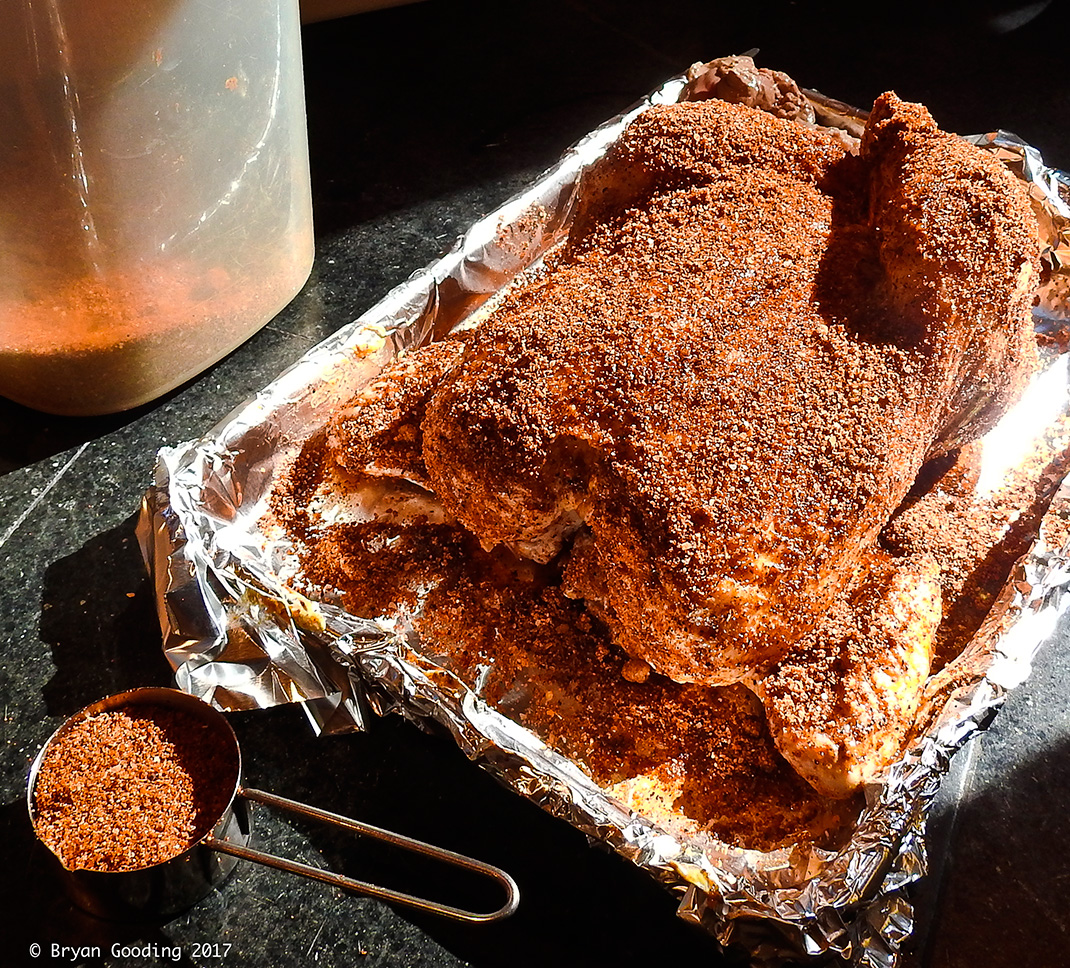
Posse member Bryan Gooding preps whole chickens for competition at the first Blues, Bandits & BBQ cookoff in Oak Cliff. (Photo ©Chris Wilkins/Texas BBQ Posse)
In barbecue and grilling, properly cooking chicken is a tough challenge.
Much of the chicken served by backyard grillers and smokers, as well as barbecue joints, is overcooked. Probably because no one wants to undercook.
Posse co-founder Chris Wilkins and I had undercooked chicken at two consecutive stops on a recent tour of Austin-area places. It’s jarring to bite into a piece of chicken and see small red splotches — blood — deep in the meat and near the bone.
At home when I grill or smoke chicken — wholes, halves, quarters — I use a temperature probe to check doneness. And even when I’m pretty sure the bird is done, I cut at a leg-thigh joint and also where the wing connects to the body to make sure. Probably not a preferred technique for a top barbecue joint.
Jerome Faulkner, the pit master at J. Leonardi’s in Austin, says he doesn’t cook half chickens anymore because it is so hard to tell when they are done. Also, chicken doesn’t hold well after it is done.
“Dark meat takes longer to cook than white meat,” Faulkner explained. “I just do leg quarters.”
And he says he knows where the hot spots are in his pit and that’s where he puts chicken.
The Travel Channel recently included J. Leonardi's among its list of five "mouthwatering" joints in Austin.

The whole bird with rub applied from Bryan Gooding's award-winning recipe for brining and smoking BBQ chicken. (Photo ©Bryan Gooding)
On the Posse, we have a couple of top cooks in Bryan Gooding and Marshall Cooper. Bryan has won best chicken a couple times at the Blues, Bandits & BBQ competition in Oak Cliff (Dallas). Marshall has teamed with John Lewis in competitions. Lewis, of course, started with Aaron Franklin in the original Franklin’s trailer, moved to la Barbecue in Austin and now runs Lewis Barbecue in Charlestown, S.C.
“Chix are tricky to get done right when you’re cooking production quantities,” Marshall responded in an email when I asked him for his thoughts.
He said when cooking in your backyard or for competitions, tracking the internal temperature of the chicken is easy.
“But when you are cooking production I’ve learned from a Chef to watch the breast,” he wrote.
When raw, the centerline of the breast meat is plump all the way across.
“But when the bird is done, the center-line depresses,” he wrote. “This is probably the trick most bbq pit master’s might not know, and over cook it to be safe.”
Marshall said it’s difficult to describe the exact look of center-line and how it develops, so it may take some practice to really understand this indicator.
Bryan uses two methods for whole chicken in competitions and at home.
In a smoker at 200-250 degrees, he cooks the bird until its internal temperature hits 170 degrees.
“I probe deep in the thigh, touch bone and back away,” Bryan wrote in an email about placement of the temperature probe. With this method, cooking time is about two hours. When done, Bryan pulls the chicken, wraps it in foil and lets it rest 20 minutes.
His second method takes about 45 minutes, cooking hot, offset on a grill. That means the chicken is not directly over the coals. He says he has never measured the cooking temperature of the grill but estimates it to be 400-450 degrees. He cooks the chicken until the internal temp hits 176, then pulls and wraps just as with his smoker method.
“Hot and fast, I found was weird and counter intuitive when compared to smoking,” Bryan explained. “If I pulled chicken at 170 from hot and fast, it was undercooked. Once I spaced out and ran chicken hot and fast to 176, It was perfect. It appears that it is not a matching curve between time and temp when moving from low heat to high heat.”
“Numero uno,” Bryan adds, “brine the chicken for at least two hours and dry completely before applying the rub.” He uses vinegar in his brine, which adds a nice tangy taste to the bird.
“I stand by my trophies,” Bryan says.
Click here for Bryan's award-winning smoked chicken recipe.

Posse member Bryan Gooding celebrates victory after winning for best chicken at the Blues, Bandits & BBQ cookoff in Oak Cliff. (Photo ©Chris Wilkins/Texas BBQ Posse)








Recent Comments